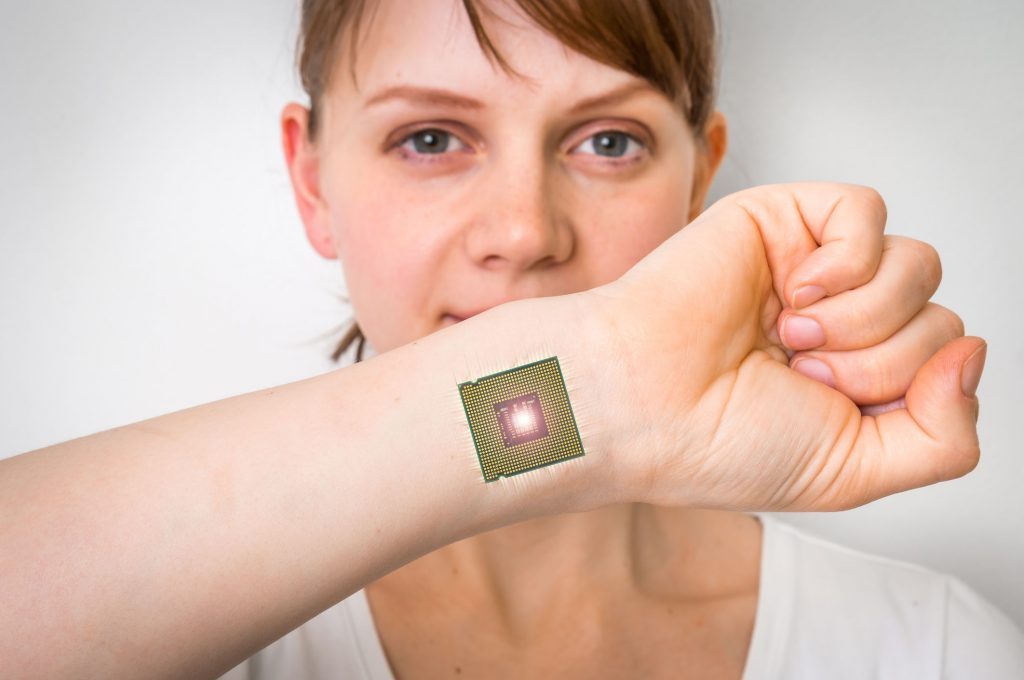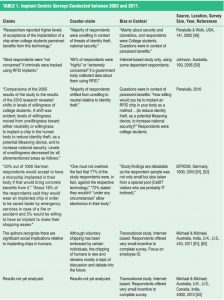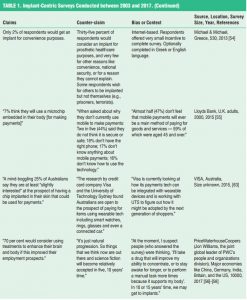 ISTOCK/andriano_cz
ISTOCK/andriano_cz A Brief Overview of Non-Medical Implants between 2013-2017 (Part 2)
In Part 1 of “Go Get Chipped” we covered the inception of microchip implants for non-medical applications from 1997 to 2012 [1]. This period demonstrated the breadth of applications that implantables could be used for [2]. This was a time of intense novelty, early hype, a bit of magic for magic’s sake, and proposing a future that very few genuinely wished to engage with, save for severe sufferers of Parkinson’s disease, Tourette Syndrome, major depressive disorder (MDD), amputation, or quadriplegia [3]. Until then, few academics, some keen biohackers, and radical start-ups had taken the idea of “microchipping people for non-medical applications”(not just dogs and cats) seriously, but things were about to drastically change when some big brands got behind the broader concept of a paperless and cashless society.
This is the normalization of the weird into the wonderful into the “cannot live without.”
Well known to most of us in the auto-ID industry were two IBM commercials produced in the mid-2000s that showed off radiofrequency identification (RFID) for “grab and go” shopping at a smart supermarket [4], and increased visibility in the supply chain [5]. In fact, the “cutesy” nature of these commercials were a step away from the original “shock and awe” of the Applied Digital Solutions VeriChip “Get Chipped” campaigns that were a response to national security (i.e., 9/11) and America’s healthcare crisis [6]. IBM instead evoked a “look how cool and fun this new tech can be — join us” kind of sentiment with their very slick and somewhat mischievous marketing approach.
In 2007, MG Michael delivered an invited talk at Terra Incognita in Montreal, Canada [7], where he showed these IBM clips as part of his uberveillance delivery, and the response was quite unexpected. At the conclusion of the meeting, this presentation was highlighted in the presence of the delegates as one of the responses contra the top heavy surveillance keynote that had been delivered earlier in the week by the second United States Secretary of Homeland Security Michael Chertoff [8]. Some years prior, MG had delivered a paper at the British Computer Society [9] where Ken Wood of Microsoft Research in Cambridge [10] and the current CTO of CISCO Monique Morrow were present [11]. It did not take long on that occasion, for the discussion on microchipping of humans to zero in on the potential for an “on-off” switch for implantables located somewhere in the human body, perhaps on the forearm. Soon after, we had chance meetings, first at an airport in India with a Nokia chief who beckoned MG to become a tech evangelist for them. There was another in 2010 in our little hometown with a longstanding InQTel employee who stated that what we were working on was the future [12]. Business cards exchanged, what were the odds we thought of all of these “touchpoints.” I too, spoke to an employee from Ericsson over breakfast about implantables at IEEE ISTAS’15 in Dublin and again, as karma struck once more, he was the very same man who wrote the article I was pointing to in our discussion [13]. So what to make of all these primary, face-to-face links, save to say that our research trajectory had been on target and this was an area of research now preoccupying the time of big business? Informal validations from very formal players — and these persons weren’t just your “think outside the box” hackers, they were executives of large multinationals who still hold major influence today.
Industry Deregulation
Initially, I had studied the historical emphasis on back-end interoperability for fundamental financial transactions in Europay, MasterCard and VISA, or what was known as the EMV alliance [14]. But dramatic things were to follow beyond “standards” and “specifications” — a wave of fullblown deregulation of the telecommunications and banking sectors across the globe then occurred bit by bit. It had become evident that traditional providers were being pressured by non-traditional players [15]. Credit card companies now had competitors who were information and communication technology (ICT) giants. It did not take long after the MONDEX card and other failed smart card initiatives for the mobile telephony revolution to gather steam and come head to head with companies like VISA. I recall the attempt in Australia to launch the “mini” VISA that one could wear as a necklace or bracelet which was literally the size of a semiconductor chip. But the horse had bolted, and soon Apple and Samsung were offering their own payment gateways [16], circumventing the need for banks or credit card companies to play any part in customer transactions.
It did not take long for the discussion on microchipping of humans to zero in on the potential for an “on-off” switch, located somewhere on the human body.
On the occasions that I’ve spoken on financial payments or financial crime in Australia, again the emphasis has been on what the future of e-payments might look like [17]. Almost always, the focus has been on how to capture the consumer’s loyalty. In some of my talks here, I have described the steady technological trajectory from luggables to wearables to implantables. Of course, big players are well aware of the trends and have sometimes denied the possibilities on the one hand [18], only to subsequently engage in the very same research they have said to sideline [19]. Scenarios are crucial for these companies. I don’t fault them for thinking about what might come next [20]. We should all be thinking with such foresight. But all of this leads to what Foster and Jaegar called “murky ethics” in one IEEE Spectrum paper I reviewed in 2007 [21]. On the one hand, big corporations saying “we’d never do it,” and on the other hand, “it’s inevitable.” This reminds me of the forthcoming volume by transhumanist commentator Lazar Puhalo on the Ethics of the Inevitable [22].
Getting Real
Yet, I am often surprised by the fact that so many people that should be in the know about the latest technologies consider most of this implant talk within the realm of “mark of the beast” or “conspiracy theory” talk. MG Michael presented a paper on anti-chipping laws in the U.S. [23] in 2009, and was bewildered by the lack of awareness of the conference audience when they are foremost ahead in social implications of technology generalist discussions. The same thing happened to me at IEEE Sections Congress 2017, when I delivered my talk more recently. Many people were stunned at the use cases I was showing. Yet, increasingly, now, due to the reach of content platforms like YouTube, awareness of what is possible is growing, as is validation of what people are claiming is happening or indeed, wanting to normalize.
For those of us keeping abreast of the latest developments day in day out, we also seem somewhat desensitized as a result of having watched endless piercings, “live” in action, streamed over the Internet. The format goes a little bit like this:
1) some nervous jokes to begin with,
2) surgical gloves come out in full view,
3) a discussion ensues about the importance of sterilization to keep infection at bay,
4) a sharp needle,
5) a tiny transponder,
6) breaking the skin,
7) a bit of blood,
8) some ad lib from the body piercer who is wearing tattoos and earimplants,
9) a hefty grin by the implantee who comments in passing “it doesn’t hurt,”
10) and then a band-aid and “that’s it” [24].
But that’s not it, and transformation takes more than just sporting an implant, although the outward bodily transfigurations cannot help but to have an inward-facing metaphysical and existential impact on the human person.


Recent Non-Medical Implantable Use Cases
An overview, not exhaustive, of some of the more significant implant usecases in the last few years, includes: GoogleX’s swallowable chip [25], dangerousthings.com (myUKI re – branded as Vivokey) [26], [27], Tim Cannon [28] and Wetware Groundhouse [29] NorthStar and Circadia, the Swedish chipping parties [30], biohacker Hannes Sjoblad [31] and co-founder and CEO of Epicenter Patrick Mesterton [32], Charlie Warzel of BuzzFeed and his epayment chip [59], the launch of DeusEx (USA and Australia) [33], chipmylife. com [34], Andreas Sjostrom (implant boarding pass) [35], Biohax International (Swedish body piercers) [36], SJRAil Priority customers (Sweden) [37], Biofoundry’s Founder Meow Meow and his Opal Card implant [38], 32Market (Wisconsin, USA) [39], [40], etc.
Among the implantees seem to be a growing list of journalists who are getting implanted for the millisecond shock factor of their online audiences. This trend will soon subside, the spectacle of something going into the body “for the first time” completely replaced by the potential flood of active nonmedical use cases. Journalists will also soon figure out that their body capacities are limited, and any future implantable will likely be taking up important “real estate” space. To the non-techy onlooker, this might seem like some form of human digital revolution (aka augmented humans), or some very extreme form of self-harm [41]. But then what of claims, from large companies like Medtronics who foresee a sensor implanted in everyone [42]? This is the normalization of the weird into the wonderful into the “cannot live without.” Companies like Cochlear in 2017 have described the potential to fuse their hearing implantable device with a service that delivers entertainment like music straight to the ear [43]. Why not? This is the blurring of the prosthetic with the amplified, the medical with the entertainment as I had once noted in a TEDXUWollongong scenario [44].
Lies, Damned Lies, and Statistics, or Is It?
It is very difficult to predict what the future has in store for us. Table 1 shows some of the key surveys to have been conducted over the last 14 years. Perhaps most confusing is the disparity of the findings between the studies, though they have all measured different things, and have sourced respondents in various markets with varying levels of technology awareness. As readers we need to be aware of the message being sold to us by companies with vested interests, and a variety of emerging stakeholders. Survey bias is ever present and as consumers we need to always ask the fundamental questions before we make our own minds up about the latest technology rewards. This is our future. We will make of it what we will. But the strategic techno-spin boiler engine rooms will just continue to grow in sophistication making it harder for consumers to believe in something other than what they are projecting. It’s time to vote with our wallets, not just our voices [60].
On the one hand, big corporations say “we’d never do it,” and on the other hand, “it’s inevitable.”
Perhaps the bigger issues at hand, as I am constantly reminded by my biohacker friends, is not whether or not some government will forcibly implant us all for social security purposes and surveillance, but what is presently happening with the mass scale big data collection strategies using social media intelligence, CCTV, behavioral biometrics using facial recognition and visual analytics to monitor human activities, the keystroke-level tracking of end-users by third parties on Internet websites, the use of in-bound technology devices that conduct ICT surveillance and home monitoring, and even fitness trackers we carry alongside our mobile phone that are set to control our health insurance premiums. I will always riposte, wait till all of these are applied together as in the full-blown Uberveillance scenario [45], [46]. We predict the integration of invasive token and non-token based payment schemes for two-factor authentication (e.g., Alibaba’s use of facial recognition payment systems in KFCs in China [47]). Already one trial that Baidu led at the beginning of this year used facial recognition technology to predict customer orders [48]. Now that’s one way to speed up transactions at the point of sale, and potentially ensure calorie controlled intake as well!
What Kind of World Do You Want to Live In?
As my last editorial as Editor-in-Chief of IEEE Technology and Society Magazine, I leave you with these final thoughts. What kind of world do you want to live in? I hope together we have continued to trail-blaze this question as a community of conscientious voices in my six years as EIC. Please never underestimate the significance of all your contributions. These don’t stem solely from scholarly works, but most likely might be in everyday discussions over a coffee to unexpectedly raise awareness about social implications of technology, or helping others harness the power of technology when there is real benefit. Personally, I have been inspired by these everyday conversations with people: with neighbors, with mums and dads, with the elderly in aged care, with young kids, with nurses, with teachers, and with those suffering from some of the negative backburn of the new technologies. Social implications of technology is not an “exclusive” topic that belongs to scientists, or academic researchers, or inventors alone, but to all of us who can observe the impacts in our own homes, our workplaces, dwellings we frequent like clubs, and even governments.
A long list of thank yous, I will need to cut short given space. Thank you to the authors who took time to research on pertinent topics of SSIT. Thank you to reviewers who freely gave of their time to offer their insights and ensure a top class benchmark was retained. To my outstanding Associate Editors and columnists who were there as a sounding board and who offered their own expert opinions, so often. To Terri Bookman who I know firsthand works round the clock to bring you the publication you see today — you have been sensational and the reason we have won so many awards. To my predecessors, Keith W. Miller and Joe Herkert, for always being there when I needed advice and practical help. And to the Vice Presidents/Presidents and Board of Governors of IEEE SSIT for all their ongoing support and direction, which I’ve always tried to incorporate. What an unforgettable experience for me! I will forever cherish the opportunity and pinch myself that it all happened. I was interviewed for the role just after my youngest child was born … I must confess it’s not always been easy, but oh so worth it! Thank you to my selfless husband whose discernment I would call upon and to my three young kids who were forever patient. I leave you in safe hands. To the forthcoming editor, Professor Jeremy Pitt of Imperial College London of whom I have the utmost respect. The trailblazing will continue on topics not previously covered, I am sure. And if his previous special issues and sections in IEEE Technology and Society are anything to go by — get ready for some spectacular work with an extensive new trusted network for SSIT to embrace.
Author Information

Katina Michael is professor at the Faculty of Engineering and Information Sciences at the University of Wollongong, Australia. Email: katina @uow.edu.au.
To access full article, including references, click HERE.






 JOIN SSIT
JOIN SSIT